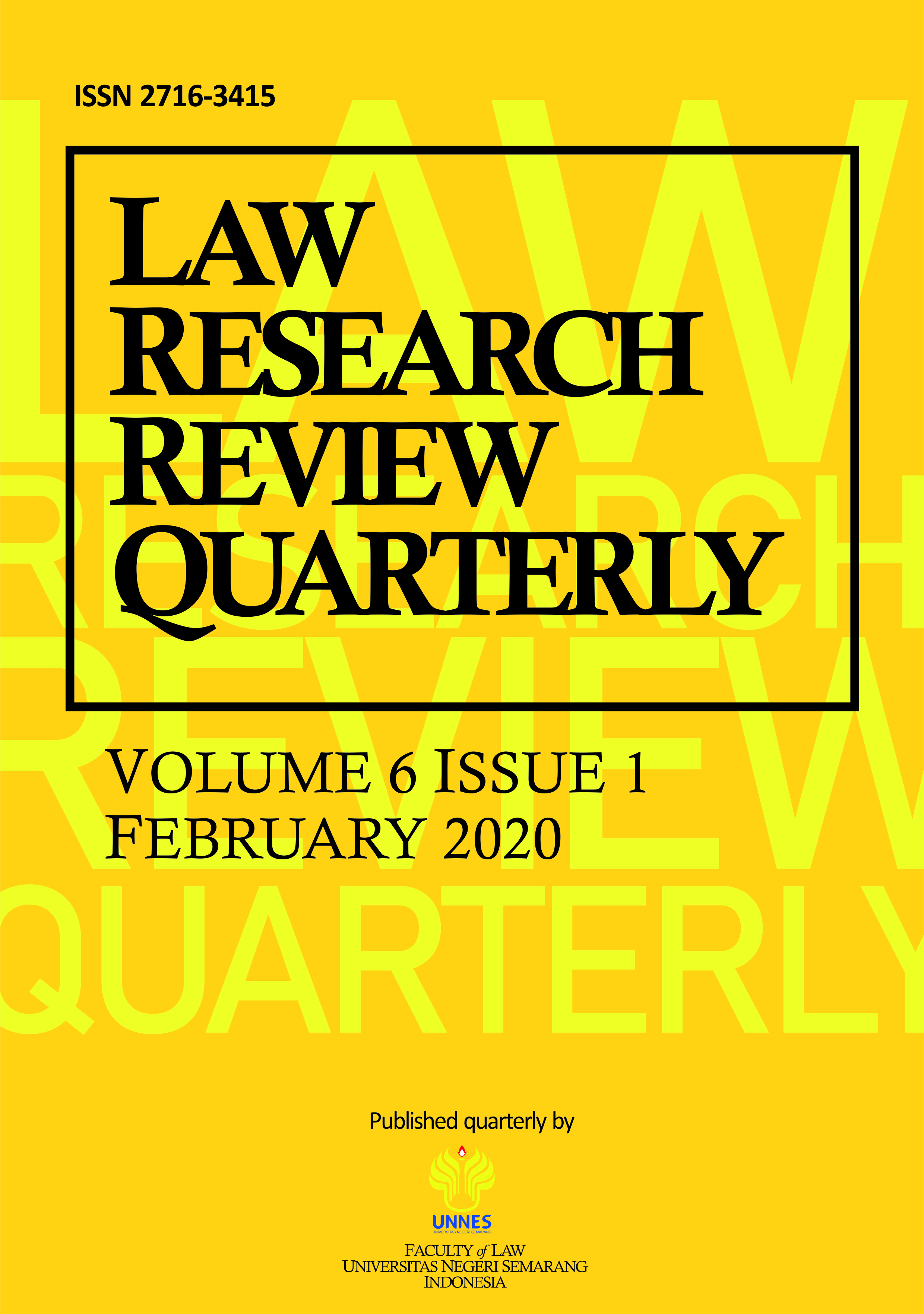Punk Community in Criminology Study (Study in Ngaliyan District, Semarang City)
Main Article Content
Abstract
The purpose of this study was to find out what criminal cases were carried out by punk children, then what factors behind them committed the crime, and why they could enter the punk community. Punk kids are always associated with a negative action, look weird, steal, children are slang, immoral, and other negative things. Sometimes punk children choose to live on the road not only a factor in the conditions of economic difficulties, but also because they enjoy environmental conditions on the road, they feel their families do not care, and lack of education. Research methods The research method used in conducting research on the criminal acts of punk children community is to use qualitative research methods with a sociological juridical approach. Qualitative research methods according to Lexy J Moleong are research that intends to understand the phenomenon of what is understood by the subject of research, such as behavior, perceptions, motivations, actions, etc., holistically and in description in the form of words and language in a natural context. Data collection uses quantitative methods. The results of the study concluded that criminal acts or crimes by punk children were carried out due to economic, family, environmental factors, and lack of education.
Article Details
All writings published in this journal are personal views of the authors and do not represent the views of this journal and the author's affiliated institutions. Author(s) are retain the copyrights of the Article. However, before publishing, it is required to obtain written confirmation from Author(s) in order to ensure the originality (Author Statement of Originality). The statement is to be signed by at least one of the authors who have obtained the assent of the co-author(s) where applicable.This work licensed under a Creative Commons Attribution-ShareAlike 4.0 International (CC BY-SA 4.0)
References
Bambang, Sunggono (2006). Pengantar Metode Penelitian Hukum. Jakarta. Rajawali Press.
Lexy J, Meleong (2013). Metode Penelitian Kualitatif. Bandung. Indonesia. PT Remaja Rosdakarya.
Moeljatno (1999). Asas- asas Hukum Pidana Edisi Revisi. Jakarta. Rineka Cipta.
Moeljatno (2011). Kitab Undang – Undang Hukum Pidana. Jakarta. PT Bumi Aksara.
Ronny, Soemitro, Hanitijo (1990). Metode Penelitian Hukum dan Jurimetri. Jakarta, Indonesia. Ghalia Indonesia
Soekanto, Soerdjono (1986). Pengantar Penelitian Hukum. Jakarta, Indonesia. Penerbit Universitas Indonesia Press.
Utari, Indah Sri (2012), Aliran dan Teori kriminologi, Thafa Media, Semarang
Suharsimi, Arikunto, (1999). Prodesur Penelitian: Suatu Pendekatan Praktek. Yogyakarta, Indonesia. Rineka Cipta.
Lan P. Moran (2010). Punk: The Do it Yourself, Social science journal, Vil. 10 Western Connecticut State University.
Thompson , Punk Productions, Unifhinised Busines.
Trumbull, M & Watson, K (2010). Qualitative Research Method. Integrating
Quantitative and Qualitative Methods in Research, 3rd Ed.pp.62. USA. University Press of America, Inc.
Yin, R.K (2011). Qualitative Research from Start to Finish. The Guilford Press.
Fadlina (2014). Data Mining untuk Analisa Tingkat Kejahatan Jalanan dengan Algoritma Association Rule Metode Apriori. Majalah Ilmiah 3(1): 144-154
Felicia Nathania,†Analisis gambaran subjektif well being korban kejahatan pencurian dan penculikan, Jurnal Psikologi Ilmiah. Fakultas Psikologi Universitas Tarumanagara. 2017
Ihsan Khairul (2016). Faktor penyebab anak melakukan tindakan kriminal. JOM FISIP Vol. 3. No. 2.
Mita Haryanto (2012). Profil Anak Punk ‘Studi Kasus Di Pasar Gemolong†Universitas Muhammadiyah Surakarta. Nakah Publikasi.
Muhammad Fakhran Al Ramadhan. (2016). Punks Not Dead: Kajian Bentukan Baru Budaya Punk di Indonesia. jurnal makna, Vol. 1.
Mukhlis, Alma Yulianti (2018). Ketertarikan Remaja Terhadap Komunitas Punk, UIN Sultan Syarif Kasim Riau.
Juliana, R., & Arifin, R. (2019). Anak dan Kejahatan (Faktor Penyebab dan Perlindungan Hukum). Jurnal Selat, 6(2), 225-234. https://doi.org/10.31629/selat.v6i2.1019
Arifin, R. (2020). Legal Reform Discourse in Indonesia and Global Context: How Does The Law Respond to Crime. Journal of Law and Legal Reform, 1(2), 193-196. https://doi.org/10.15294/jllr.v1i2.37057
Muhtada, D., & Arifin, R. (2018). Introducing JILS 3(2), November 2018 Edition: Crimes and Society and its Contemporary Issues. JILS (Journal of Indonesian Legal Studies), 3(02), 147-148. https://doi.org/10.15294/jils.v3i02.27604
Arifin, R., Waspiah, W., & Latifiani, D. (2018). Penulisan Karya Ilmiah untuk Mahasiswa Hukum. Semarang: BPFH UNNES.
Undang Undang Nomor 23 Tahun 2002 tentang Perlindungan Anak.
Undang- Undang No. 11 Tahun 2012 tentang Sistem Peradilan Pidana Anak.
www. Punk. Com.. diakses pada tanggal 10 Mei 2019.
Respository.uin.jkt.ac.id.diakses pada tanggal 10 mei 2019.
Uksw.education. Komunitas punk salatiga. Diakses 12 mei 2019.
